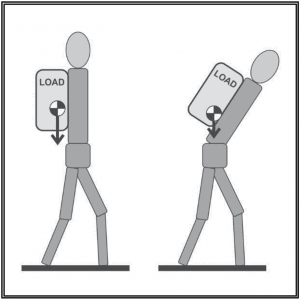
It is recommended to carry 10% – 15% of your bodyweight when you start rucking. Add weight in 5 – 10 pound increments as you progress in your training program. A 200 pound man should carry 25 lbs to 40 lbs and continue to increase the weight in 5 or 10 pound increments.
Some blogs and programs recommend that you start carrying 20% – 25% of your body weight. Our recommendation and what is commonly agreed on is that the most important step is to actually start!
Everyone is at a different fitness level in their fitness journey. So when you’re deciding on the amount of weight you should carry, the best advice is to simply listen to your body!
If the weight is too light, then you’re not making the best out of your workout and probably will not burn as much calories as you’re hoping to burn. This may slow down your weight loss journey.
On the flip side, carrying too much weight can be counterproductive. If the weight you’re carrying is too heavy, you probably wont be able to ruck for long and may have to resort to end your ruck too early. This may also lead to common rucking injuries.
The lesson here is to be honest with yourself and carry the weight that you know is challenging enough for a good workout.
Carrying the right weight, when first starting out, is key to being a consistent rucker. I noticed that some people who start rucking tend to quit because they’re carrying too much weight and are expecting to see results quickly. Therefore, I created a guide on why rucking is so hard and how you can make it easier to ensure consistency which will guarantee you the results you’re looking for.
What is the Best Weight To Carry For Rucking?

Start with 10% – 15% of your bodyweight. The rationale behind carrying weight in this weight range is that when you’re first starting out, you dont want to overwork your body.
Your body is just getting familiar with the new workout. It is using muscles that it is not used to being used for that long.
Rucking sessions are typically longer than 30 minutes so if you have weak shoulder muscles (deltoid & traps), then you don’t want to punish them right from the get go of your rucking training plan.
Once you’ve completed your first 3 rucking workouts, that will give your body enough time to recover and you will be able to determine
- If the weight load is too heavy or too light
- if you need to strengthen certain body parts
- if you need to upgrade your rucking gear
Eventually, preferably a week into your rucking program, you should assess your performance and ask yourself this question.
Can I ruck the same distance as the prior week and carry 5 – 10 pounds more?
If you’ve answered yes to that question, then go ahead and add that weight.
If you’ve answered no, that’s fine too! Keep that same weight and you’ll eventually get used to that weight load and eventually increase weight!
Rucking Weight Tip #1: Keep in mind that if you’re carrying a rucksack that is heavy on its own, you may want to factor that in when you’re deciding on how much weight you should carry in your ruck session.
How To Know If You’re Carrying Too Much Weight
Here are a few ways to diagnose your weight load and figure out if you’re carrying too much weight in your ruck session:
1- You Started Rucking With A Weight Load More Than 10% – 15% Of Your Body weight
As we previously explained, we encourage carrying 10% – 15% of your bodyweight when you’re starting. It can be very tempting to one up your rucking buddies or carry a heavier weight load to flex on your friends, but you wont be flexing for too long because that’s not sustainable.
It’s much better for you to ruck with a regular weight load and ruck more frequently as opposed to rucking a few times a month. Especially if you have a fitness goal such as gaining strength or losing weight.
2- Your Posture Is Completely Off

If you’ve been rucking for a while with improper form, you will feel it. Trust us, been there done that. Depending on how you’re carrying your rucksack, improper form can result in back or knee pain. Those are the common ones at least.
Here’s how to ruck with proper form:
- Keep your back straight with your shoulder rolled back
- Keep the backpack close to your back
- Wear a hip belt if your rucksack is not close to your back in order to redistribute the weight
3- You’re getting Injured Too Often

This one speaks for itself but if your getting injured too often. then reducing the weight may be the right call. There’s nothing wrong with reducing the weight load. As we previously said, listen to your body!
Rucking Weight Tip #2: Track your workouts so you can look back and assess your performance if you hit a plateau. You can use different rucking apps to keep track of the distance and calories (although we wouldn’t rely on that solely to track calories burned). You can add notes and this is where you can write down how much weight you carried per rucking session.
Recommended Rucking Plan
Following a rucking plan will help you stay motivated and help you stick to your workouts. Here’s a simple rucking plan that we recommend if you’re just starting out and trying to pin point the right weight load.
| Week or Stage | Rucks Per Week | Distance | Duration | % of BW |
|---|---|---|---|---|
| Week/ Stage 1 | 2-3 | 2 miles | 1 hour | 15% |
| Week/ Stage 2 | 2-3 | 2.5 miles | 1.5 hour | 15% – 20% |
| Week/ Stage 3 | 2-3 | 2.5 miles | 2 hours | 20% |
| Week/ Stage 4 | 2-3 | 3.0 miles | 2 hours 20 minutes | 20% – 25% |
| Week/ Stage 5 | 2-3 | 3.5 miles | 2 hours 20 minutes | 20% – 25% |
We use stage or week because you can always repeat that week if you don’t feel prepared to add more weight or increase the distance. Use the rucking plan as a template. Feel free to customize it but make sure its challenging enough!
Rucking Weight Tip #3: If you’re not using ruck plates for weight and are rucking on a flat terrain, place heavy items on top to help you stay upright. If you’re rucking on a non-flat terrain, try to distribute your weight as evenly as possible.
When should You Increase weight for Rucking?
Increasing weight for rucking should be a gradual and strategic process to ensure your safety and progress. Here are some factors to consider when deciding when to increase the weight:
1. Form: Make sure you’re comfortable carrying the weight that you’re currently at. If your form is intact and you’re seeing consistent improvement, it’s worth considering increasing your weights.
2. Endurance: If your pace is improving and you’re feeling relatively comfortable with your current weight load without having to sacrifice your form, it’s worth adding more weight to your ruck.
3. Gains in strength: If you’ve noticed improvements in your strength and feel as though you can add more weight to further increase your strength, consider adding more weight.
Remember, when adding more weights to your ruck, I strongly recommend adding more weight incrementally, 5 – 10 pounds will do.
Rucking Weight Related Questions
Should I Carry More Weight Or Shorten the Distance?
If you’re goal is to increase your weight load for a particular rucking event or to meet the military requirement, then it is recommended to ruck for shorter distance with a heavier weight load. This is because you need to get your body to tolerate the increased weight load (source).
However, if your goal is to incorporating rucking as part of your fitness regimen, then it is better to carry less weight (than your absolute max load) and ruck for a longer distance to get your heart rate elevated for a longer period of time.
Rucking Weight Tip #4: Should you find yourself in a situation where you have to carry a heavy weight load and you’re unable to reduce the weight, you should take shorter and faster strides to maximize efficiency.
What Should You Carry For Weight When Rucking?
Check out our post, 25 ideas of what to put in rucksack for weight , for a full list of ideas.
What Can You Do To Increase Weight Load For Rucking?
Incorporating weight lifting exercises that include compound movements such as deadlifts, squats, farmers walk will help you gain strength. Check out our best exercise for rucking for more.
What is the Maximum Weight Recommended to Carry?
A common suggested maximum weight to carry during rucks should be around 20% – 30% of your bodyweight. The maximum amount of weight for your rucks should be adjusted towards your fitness level, experience, and the event.
You should not start at this weight category as you’re more prone to injury, especially if you’re just starting out.
How Heavy is too Heavy for Rucking?
“Too heavy” for rucking is when you find the weight is causing you to compromise your posture, experience sharp pain, or significantly slow down your pace.
Of course, it goes without saying that “Too heavy” for rucking varies based on individual factors such as fitness level, experience, and the purpose of the ruck. However, a general guideline is that the weight should challenge you without causing strain or potential injury.
